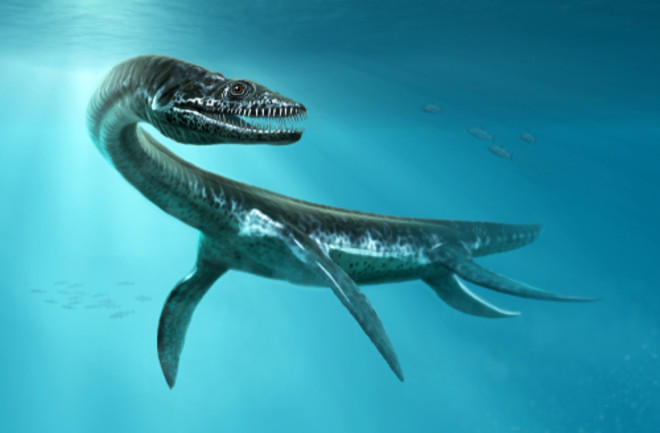Prehistoric reptiles roamed every corner of the Earth millions of years ago — including the depths of the ocean to streams and rivers. While commonly referred to as aquatic or marine dinosaurs — or reptiles — many of these creatures also spent a significant amount of time out of the water.
Some prehistoric marine reptiles came to the surface to breathe or returned to land to lay their eggs. Here are five of the most interesting aquatic reptiles that lived among the dinosaurs.
1. Spinosaurus
Larger than the Tyrannosaurus Rex, the Spinosaurus was the largest known carnivorous dinosaur. Reaching over 20 feet tall and up to 65 feet long, these enormous creatures could weigh in at 26,000 to 44,000 pounds. Although they lived primarily in water, they were not ocean dwellers. Instead, they lived in rivers and lakes in Northern Africa — in what is now modern-day Morocco and Egypt.
Despite having a paddle-like tail and spending time in water, newer research suggests that they would not have been proficient swimmers and could not submerge themselves. Spinosaurus had long (up to seven feet) spines extending from their vertebrae, called a sail. Paleontologists hypothesize this sail was used to attract mates and deter enemies.
Read More: Could Spinosaurus Really Take On T. rex? And Other Facts
2. Mosasaurus
These massive, 30,000-pound, ocean-dwelling reptiles lived in various climates, with fossils found in Africa, Asia, Europe, Antarctica and the Americas. With 40-50 enormous, sharp teeth and a double-hinged jaw, Mosasaurus could open its mouth wide enough to swallow its prey whole.
They were an apex predator growing up to 48-56 feet long and weighing about 15 tons. With almost no other predators, they often fought each other — with the winner feeding on the loser. Their modern-day relatives include the monitor lizard and Komodo dragon.
Read More: Did This Giant Sea Lizard Rule the Oceans 66 Million Years Ago?
3. Kronosaurus
Paleontologists have found fossils from the ocean-dwelling Kronosauras in only Australia and Colombia. However, the fact that their bones were found on two continents so far apart suggests they lived worldwide. The lack of fossil evidence further points to Kronosauras living in deep waters rather than shallow.
Feeding on marine reptiles, sharks, fish, large squid and turtles, they weighed in at up to 28,000 pounds and measured up to 34 feet long. The world’s only mounted Kronosaurus skeleton is at the Harvard Museum of Natural History. There is an interesting story about the display (related to its reconstruction), and it is not without some controversy.
Read More: Why Were Prehistoric Marine Reptiles So Huge?
4. Plesiosaurus
With disproportionately long necks, the Plesiosaurus did not look like a streamlined specimen. But research suggests otherwise. Using computer modeling, scientists studied the drag of Plesiosaurus as compared to other marine reptiles and modern-day dolphins and whales. They did this by modeling how water would have flowed around their bodies to determine the resistance they would have experienced while swimming.
Surprisingly, Plesiosaurs had an impressive drag per unit volume, leading researchers to believe they may have been adept swimmers. Using their four fins and a head that could swing from side to side, they likely moved through the water, feeding on schools of fish.
Read More: How Do Scientists Reconstruct What Dinosaurs Looked Like?
5. Shonisaurus
Paleontologists first discovered this fossil in Nevada in 1920 and aptly named it Shonisauras, meaning “lizard from the Shoshone Mountains.” Although excavations did not begin until 1954, eventually, paleontologists and researchers unearthed 37 of these fossils. Shonisauras was somewhat similar to what we think of as a modern-day dolphin.
Shonosauras was the largest of the ichthyosaur genera and had a longer snout and narrower flippers than the other Ichthyosaurs. Growing to approximately 50 feet long, they would generally stay immersed in deep oceanic water, although they came closer to shore at night when feeding.
The adults did not have teeth, losing them as juveniles. The lack of teeth meant that they fed on cephalad, such as squid. With four equal-sized limbs, they were skilled at swimming at different depths, allowing them a feeding advantage.
Read More: Do We Still Have Any Species Today That Are Descendants of Dinosaurs?

